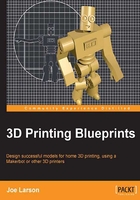
Choosing a modeling tool
There are many choices of modeling programs that can be used to produce 3D printable objects. There are many factors including versatility, simplicity, and cost to take into account. A tool with too steep a learning curve can turn off new users to the idea all together. A tool with too limited a set of tools can frustrate a user when they hit the limit. Investing a lot of money into something that doesn't end up going anywhere can be extremely disappointing. So it is important to explore the options.
SolidWorks (www.solidworks.com) and other drafting oriented programs can do technical shapes with extreme precision. They include the necessary tools to accurately describe a shape that can be brought into the real work with high fidelity. However these sorts of tools tend to be costly and don't do artistic or organic shapes very well. Their highly technical nature also gives them a steep learning curve.
OpenSCAD (www.openscad.org) is free and famous among the people who make 3D printers and can make technically accurate models as well. OpenSCAD also allows the models to be parametric, meaning that by changing a few variables and recalculating a new shape is generated. But OpenSCAD is difficult to use unless the user has a very technical and programmatic mind since the shapes are literally built from lines of code.
Zbrush (pixologic.com/zbrush), Sculptris (pixologic.com/sculptris), or Wings3D (www.wings3d.com) are great tools for modeling organic shapes like the kind used in video games or animation. Sculptris and Wings3D are free and are very easy to pick up and use. But these tools lack when precision is necessary.
Sketchup (www.sketchup.com) is a great free program with a library of shapes built in ready to import and play with. Its modeling tools are great for precise or architectural models. Sketchup doesn't do organic shapes well either and it can be tricky loading the plug-ins necessary for Sketchup to export their models to something printable. Even then models from Sketchup often have to go through an extensive clean up phase before they'll be ready to print.
Autodesk 123D (www.123dapp.com) is not one but a whole suite of free programs designed around 3D modeling with specific focus on 3D printing. There are programs to design creatures or precise shapes. There is even an app for converting pictures of real life objects into 3D models. Some are programs that run in browser, some are downloads and some are apps for Apple devices. It's an eclectic and powerful group of programs. The Autodesk 123D suite's weakness is in its general immaturity. Autodesk is making great efforts to make modeling for 3D printing accessible for everyone but its tools still need to mature somewhat before they'll be ready to explore in depth.
Blender (blender.org) is a 3D animation program that features a robust set of modeling tools. Good for artistic and organic shapes, it can also be used when precision is needed. On top all that it is free and open source, so it is still in constant development. If Blender doesn't have a particular feature it is only a matter of time until it will be added. If fact by the time this book is published chances are the version of Blender used to make it will already be out of date, but most of Blender's functionality remains unchanged version-to-version. Blender is also completely customizable so that every feature, from the key strokes used to the overall look, can be changed. The downside of Blender is that its user interface is somewhat unintuitive. This causes Blender to have a famously difficult learning curve
Because of Blender's versatility and availability it is the tool of choice for the beginning 3D designer and this work.